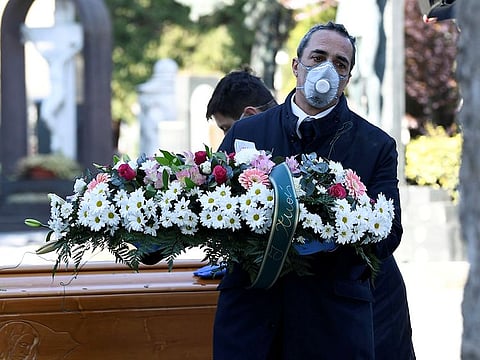25,000 missing deaths: Tracking true toll of COVID-19
Numbers undermine notion that many who died from virus may soon have died anyway

New York: At least 25,000 more people have died during the coronavirus pandemic over the last month than the official COVID-19 death counts report, a review of mortality data in 11 countries shows - providing a clearer, if still incomplete, picture of the toll of the crisis.
In the last month, far more people died in these countries than in previous years, The New York Times found. The totals include deaths from COVID-19 as well as those from other causes, likely including people who could not be treated as hospitals became overwhelmed.
These numbers undermine the notion that many people who have died from the virus may soon have died anyway. In Paris, more than twice the usual number of people have died each day, far more than the peak of a bad flu season. In New York City, the number is now four times the normal amount.
Of course, mortality data in the middle of a pandemic is not perfect. The disparities between the official death counts and the total rise in deaths most likely reflect limited testing for the virus, rather than intentional undercounting. Officially, about 177,500 people have died worldwide of the coronavirus as of Wednesday morning.
But the total death numbers offer a more complete portrait of the pandemic, experts say, especially because most countries report only those COVID-19 deaths that occur in hospitals.
“Whatever number is reported on a given day is going to be a gross underestimate,” said Tim Riffe, a demographer at the Max Planck Institute for Demographic Research in Germany. “In a lot of places the pandemic has been going on for long enough that there has been sufficient time for late death registrations to come in, giving us a more accurate picture of what the mortality really was.”
Double the number
The differences are particularly stark in countries that have been slow to acknowledge the scope of the problem. Istanbul, for example, recorded about 2,100 more deaths than expected from March 9 through April 12 - roughly double the number of coronavirus deaths the Turkish government reported for the entire country in that period. The increase in deaths in mid-March suggests that many people who died had been infected in February, weeks before Turkey officially acknowledged its first case.
In March, the Indonesian government attributed 84 deaths to the coronavirus in Jakarta. But over 1,000 people more than normal were buried in Jakarta cemeteries that month, according to data from the city’s Department of Parks and Cemeteries.
The New York Times estimated the excess mortality for each country by comparing the number of people who died from all causes this year with the historical average during the same period.
In many European countries, recent data show 20 per cent to 30 per cent more people have been dying than normal. That translates to tens of thousands of more deaths.
Mortality data
Deviations from normal patterns of deaths have been confirmed in many European countries, according to data released by the European Mortality Monitoring Project, a research group that collects weekly mortality data from 24 European countries.
It is unusual for mortality data to be released so quickly, demographers say, but many countries are working to provide more comprehensive and timely information because of the urgency of the coronavirus outbreak. The data is limited and, if anything, excess deaths are underestimated because not all deaths have been reported.
“At this stage, it’s a partial snapshot,” said Patrick Gerland, a demographer at the United Nations. “It’s one view of the problem that reflects that most acute side of the situation, primarily through the hospital-based system.”
That is likely to change.
“In the next couple of months,” Gerland said, “a much clearer picture will be possible.”
Sign up for the Daily Briefing
Get the latest news and updates straight to your inbox







